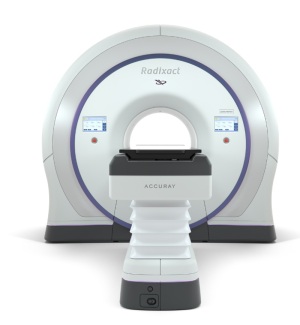by
Lauren Dubinsky, Senior Reporter | September 16, 2016
From the September 2016 issue of HealthCare Business News magazine
“The goal of radiation therapy for cancer is to [administer] the radiation accurately into the cancer without irradiating too much healthy tissue,” says X. Allen Li, professor and chief of medical physics at the Medical College of Wisconsin. He intends to do that with the new Elekta MR-linac system that’s soon to be installed at the college. The system integrates a radiotherapy system, a high-field MR scanner and software that allows the physicians to see the patient’s anatomy in real time. They’re able to locate the tumor and stay on track during delivery, even when the tumor tissue moves or changes shape, location or size.
Elekta initiated its MR-linac Consortium in 2012 along with Royal Philips. Since then, the University Medical Center Utrecht in the Netherlands, The University of Texas MD Anderson Cancer Center and The Netherlands Cancer Institute have installed the system. The standard of care for radiation therapy relies on CT, but it’s not able to identify soft tissue for many tumor sizes, says Li.
Benefits of MR



Ad Statistics
Times Displayed: 797
Times Visited: 5 Keep biomedical devices ready to go, so care teams can be ready to care for patients. GE HealthCare’s ReadySee™ helps overcome frustrations due to lack of network and device visibility, manual troubleshooting, and downtime.
The major advantage of MR is its ability to image soft tissue, which allows the tumor to be targeted more accurately. In the past, radiation therapy could treat pancreatic cancer within 1 centimeter of the target lesion, but MR allows for accuracy within 5 millimeters. “The tumor or normal tissue may change due to the radiation delivery,” says Li. “MR can identify that type of behavior so we can adjust the radiation for the patient. That personalizes the radiation therapy delivery.”
Dr. Brian Kavanagh, chair of the department of radiation oncology at the University of Colorado and president-elect of ASTRO, also believes that MR-linac may offer advantages over the current standard. “The MR can often give a sharper image than a CT scan, depending,on the body part you are looking at, and this by itself could be a valuable advantage,” he adds. MR can also provide more information on tumor physiology and response to treatment, even while the treatment is still ongoing. That additional data can be translated into actionable information that could lead to modifications early in treatment based on the patient’s tumor response.
Despite the advantages, it’s going to take a while for hospitals to adopt MR to assist with radiation therapy, says Li. The early adopters are working to rigorously design clinical trials to demonstrate how the technology can help patients. “Once we start to see the clinical impact and the outcome change and the cost of the technology drops, then the pace of adoption will increase,” says Li.

